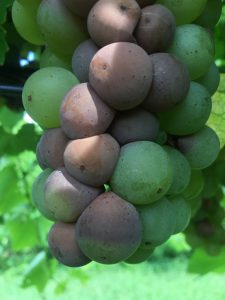Sour rot is showing up in some Georgia vineyards (see photo below), and this is really no surprise with our environment. The classic vinegar smell in the vineyard helps to identify sour rot, as other rots are somewhat similar as they initially develop. We have issues with this disease complex to some degree in most years. Just to reiterate from a previous post, Megan Hall has conducted research at Cornell which may be the first to give some hope of managing sour rot. She indicated that her research supports the use of mainly MustangMaxx, but Oxidate plus MustangMaxx (or other SWD materials) provides the best suppression of sour rot. She states, “If a grower knows that they regularly see sour rot in a particular variety, I recommend beginning to spray at approximately 15 Brix using OxiDate and MustangMaxx weekly until harvest.” She still recommends the Oxidate, but she also indicated that the MustangMaxx is the heavy hitter. Without MustangMaxx, the Oxidate product does nothing, according to Megan. Please realize that you will need to incorporate other SWD-active insecticides in a rotation with MustangMaxx, as you do not want to go to that well too often — resistance will develop. Please consult with our county agents if you have questions concerning insecticides and rotations; ultimately, Brett Blaauw, our extension entomologist, is the source of information concerning insecticide information, but please contact your local county agent as a starting point on questions such as these. See below for an abstract of a presentation that Megan will present tomorrow on her research. The abstract may be a bit technical for some, but I think it will give you the basic background behind what she has learned about the sour rot complex. I will be at her talk, and if I learn anything new, I will update this post.

Megan Hall’s abstract from her presentation at the American Phytopathological Society:
Sour rot is a disease complex affecting grape growers and winemakers worldwide, characterized by the oxidation of the berry skin, internal development of acetic acid and partnered with the presence of Drosophila fruit flies. We have shown that acetic acid production requires yeast to produce ethanol and bacteria to subsequently convert the ethanol to acetic acid through an oxidation reaction. We have characterized the microorganisms involved, determining that several yeast species (Saccharomyces spp., Hanseniaspora spp., and Pichia spp.) partnered with acetic acid bacteria (Gluconobacter spp. and Acetobacter spp.) can cause this reaction, but only in the presence of Drosophila spp. To investigate potential non-microbial contributions of Drosophila spp. to the complex, we produced axenic D. melanogaster eggs and reared larvae until axenic conditions, yielding adults devoid of gut or surface microbiota. Wounded berries exposed to the wild type flies for 8 days produced typical sour rot symptoms, but in order for symptom development to occur in those in the presence of axenic flies, co-inoculation with a yeast and acetic acid bacteria was required. In field trials conducted on cv. ‘Vignoles’ in 2013-16, both insecticide and antimicrobial treatments significantly reduced sour rot development. In 2015, untreated vines averaged 20.5% sour rot severity, and this was reduced by 73-81% on vines treated prophylactically post-veraison with weekly sprays containing a combination of the insecticide zeta-cypermethrin plus the antimicrobial potassium metabisulfite or hydrogen dioxide; severity was reduced by 49% on vines receiving only insecticide sprays. These trials further support the hypothesis that sour rot results from a complex of yeast, bacteria, and Drosophila spp. and that targeting these organisms can provide significant levels of control.